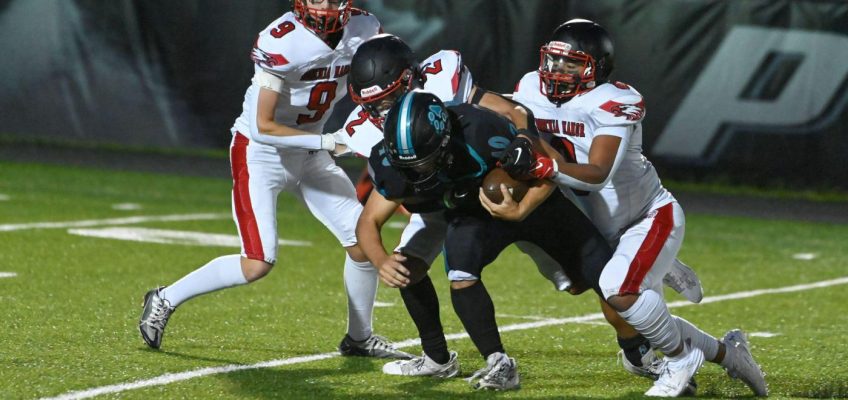Wisconsin wildlife officials unanimously approved a contentious new wolf management plan Wednesday that doesn’t include a specific population goal despite demands from hunters and farmers to cap the number of wolves roaming the state.
In backing the plan, Department of Natural Resources policy board members praised it as a scientifically sound compromise that could give federal officials confidence that Wisconsin would manage its wolf population responsibly if the federal government removes protections for the species.
“Impressive work,” board member Todd Ambs told DNR large carnivore specialist Larry Johnson, who spent months developing and revising the plan in an attempt to please hunters, farmers and conservationists. “Amazing what you’ve been going through. … Congratulations on still being upright when you got here.”
Wolf management has become one of the fiercest policy debates in Wisconsin hunting circles as the population has grown over the last three decades.
Farmers in northern Wisconsin have long complained that wolves are preying on their livestock. The DNR has recorded 67 confirmed or probably wolf attacks on livestock, pets and hunting dogs so far in 2023, up from 49 in all of 2022. Hunters believe the animals are devastating the deer population in the northern reaches of the state. Conservationists counter that wolves haven’t firmly established themselves in the state and should be protected.
The DNR adopted a wolf management plan in 1999 that called for capping the population at 350 wolves. The latest DNR estimates, however, indicate the population currently stands at around 1,000 wolves.
With the population growing, Republican legislators in 2012 passed a law requiring the DNR to hold an annual wolf hunting season. Hunters and farmers have pointed to the 350-wolf limit as justification for setting high kill quotas, angering animal rights activists.
A federal judge last year placed gray wolves in the lower 48 states back on the endangered species list, making hunting illegal and limiting farmers to nonlethal control methods, such as fencing in livestock or using guard dogs. The DNR has been working on an updated wolf management plan in case wolves are removed from the list and hunting resumes.
The new plan recommends a statewide population of about 1,000 animals but doesn’t set a hard limit on the population. Instead, the plan recommends allowing the population to grow or decline at certain numerical thresholds. DNR officials insist the plan creates flexibility in dealing with local packs, allowing for more hunting pressure in areas overpopulated with wolves.
The proposal has met with sharp criticism from farmers and hunters who want to see a specific statewide population goal. The Wisconsin Farm Bureau Federation, the largest farmers association in the state, has called for maintaining the 350-wolf cap and Republican lawmakers are advancing a bill that would force the DNR to insert a specific number in the plan.
Republicans who control the state Senate on Oct. 17 refused to confirm four members of the DNR board who said they supported the new management plan, removing them from the board. Democratic Gov. Tony Evers named four replacements the same day.
The board spent more than three-and-a-hours before the vote listening to public comments on the plan from both sides.
Alex Mardosky, associate director of the Nature Conservancy in Wisconsin, called the plan “exceptional.” He praised the DNR for moving toward a flexible management approach, calling a hard population goal “a really blunt instrument.” He recommended the DNR set a zero quota if hunting resumes.
Ed Harvey of the Conservation Congress, a group of influential sportsmen who advise the DNR, said the organization doesn’t think the plan should keep the 350-wolf goal. He complained that the department hasn’t given enough weight to the opinions of people who live among wolves.
Patrick Quaintance, of Bayfield, said he’s seen the remains of calves killed by wolves on farms around his property and has taken photos of wolves in broad daylight. “I don’t feel safe walking my dog or turning my dog loose on my property,” he said. “Let’s keep this in perspective. People are having problems with wolves.”
There has never been a documented wolf attack on a human in Wisconsin, according to the DNR. Wolves typically prey on old, young, sick or otherwise weakened animals, although the department has said that wolves could start acting more aggressively toward people as they become habituated to them.
Fred Clark, executive director of conservation group Wisconsin’s Green Fire, said his group supports the plan and that the 350-wolf goal in 1999 means nothing because scientists have had 24 years to learn more about wolves. He said the plan will help persuade federal wildlife officials that they can hand wolf management back to the states in good conscience.
“The feds are paying attention,” Johnson, the DNR’s large carnivore specialist, told the board. “(They’re) looking for a plan that lays out our intentions. It’s really important to put our best foot forward as a state so when that delisting comes we can maintain it long-term.”
The board also voted unanimously to approve new regulations governing the state’s wolf season. The DNR has been relying on emergency rules crafted after Republicans passed the 2012 law establishing a hunt.
The new regulations largely duplicate the emergency provisions but do include some changes to reflect goals in the management plan. Notable changes include shrinking the 24-hour period for registering kills to eight hours. Hunters would be allowed to train dogs to track wolves only during the wolf season and would be barred from destroying dens.
The new rules retain existing prohibitions on hunting wolves with dogs at night.
Semi-truck driver among 2 killed, 6 injured in fiery crash along I-94 in western Wisconsin
Hudson city administrator to step down
Aging U.S. power grid to get $3.5B update; Minnesota to share largest grant
Few Republicans have confidence in elections. It’s a long road for one group trying to change that in Wisconsin.
Wisconsin Supreme Court is asked to redraw legislative boundaries created by Republicans




